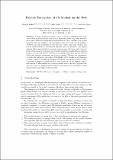Files in this item
Fidelity perception of 3D models on the web
Item metadata
| dc.contributor.author | Bakri, Hussein | |
| dc.contributor.author | Miller, Alan Henry David | |
| dc.contributor.author | Oliver, Iain Angus | |
| dc.contributor.editor | Beck, Dennis | |
| dc.contributor.editor | Allison, Collin | |
| dc.contributor.editor | Morgado, Leonel | |
| dc.contributor.editor | Pirker, Johanna | |
| dc.contributor.editor | Peña-Rios, Anasol | |
| dc.contributor.editor | Ogle, Todd | |
| dc.contributor.editor | Richter, Jonathon | |
| dc.contributor.editor | Gütl, Christian | |
| dc.date.accessioned | 2018-07-17T12:30:06Z | |
| dc.date.available | 2018-07-17T12:30:06Z | |
| dc.date.issued | 2018 | |
| dc.identifier | 253067803 | |
| dc.identifier | 73019693-f7bd-4c12-9f5a-2146fc700019 | |
| dc.identifier | 85049104084 | |
| dc.identifier | 000694942000008 | |
| dc.identifier.citation | Bakri , H , Miller , A H D & Oliver , I A 2018 , Fidelity perception of 3D models on the web . in D Beck , C Allison , L Morgado , J Pirker , A Peña-Rios , T Ogle , J Richter & C Gütl (eds) , Immersive Learning Research Network : 4th International Conference, iLRN 2018, Missoula, MT, USA, June 24-29, 2018, Proceedings . Communications in Computer and Information Science , vol. 840 , Springer , Cham , pp. 113-130 , Fourth Annual International Conference of the Immersive Learning Research Network (iLRN 2018) , Missoula , Montana , United States , 24/06/18 . https://doi.org/10.1007/978-3-319-93596-6_8 | en |
| dc.identifier.citation | conference | en |
| dc.identifier.isbn | 9783319935959 | |
| dc.identifier.isbn | 9783319935966 | |
| dc.identifier.issn | 1865-0929 | |
| dc.identifier.other | ORCID: /0000-0001-9118-4594/work/126553916 | |
| dc.identifier.other | ORCID: /0000-0003-1209-9063/work/127065704 | |
| dc.identifier.uri | https://hdl.handle.net/10023/15483 | |
| dc.description.abstract | Cultural heritage artefacts act as a gateway helping people learn about their social traditions and history. However, preserving these artefacts faces many difficulties, including potential destruction or damage from global warming, wars and conflicts, and degradation from day-to-day use. In addition, artefacts can only be present in one place at a time, and many of them can not be exhibited due to the limited physical space of museums. The digital domain offers opportunities to capture and represent the form and texture of these artefacts and to overcome the previously mentioned constraints by allowing people to access and interact with them on multiple platforms (mobile devices, tablets and personal computers) and network regimes. Through two experiments we study the subjective perception of the fidelity of 3D models in web browsers in order to discover perceptible resolution thresholds. This helps us create models of reasonable graphical complexity that could be fetched on the biggest range of end devices. It also enables us to design systems which efficiently optimise the user experience by adapting their behaviour based upon user perception, model characteristics and digital infrastructure. | |
| dc.format.extent | 9930234 | |
| dc.language.iso | eng | |
| dc.publisher | Springer | |
| dc.relation.ispartof | Immersive Learning Research Network | en |
| dc.relation.ispartofseries | Communications in Computer and Information Science | en |
| dc.rights | © 2018, Springer International Publishing AG. This work has been made available online in accordance with the publisher’s policies. This is the author created accepted version manuscript following peer review and as such may differ slightly from the final published version. The final published version of this work is available at https://doi.org/0.1007/978-3-319-93596-6_8 | en |
| dc.subject | 3D Web | en |
| dc.subject | Heritage | en |
| dc.subject | Perception | en |
| dc.subject | Fidelity | en |
| dc.subject | QoE | en |
| dc.subject | AM Museums (General). Collectors and collecting (General) | en |
| dc.subject | QA75 Electronic computers. Computer science | en |
| dc.subject | NDAS | en |
| dc.subject.lcc | AM | en |
| dc.subject.lcc | QA75 | en |
| dc.title | Fidelity perception of 3D models on the web | en |
| dc.type | Conference item | en |
| dc.contributor.institution | University of St Andrews.School of Computer Science | en |
| dc.contributor.institution | University of St Andrews.Centre for Ancient Environmental Studies | en |
| dc.identifier.doi | 10.1007/978-3-319-93596-6_8 |
This item appears in the following Collection(s)
Items in the St Andrews Research Repository are protected by copyright, with all rights reserved, unless otherwise indicated.

